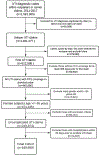Characteristics Associated With Repeated Evaluations for Urinary Tract Infections in Older Women: A Case-Control Study
- PMID: 35234180
- PMCID: PMC9035018
- DOI: 10.1097/SPV.0000000000001129
Characteristics Associated With Repeated Evaluations for Urinary Tract Infections in Older Women: A Case-Control Study
Abstract
Objectives: The aims of this study were to estimate the incidence of repeated evaluations for urinary tract infection (UTI) after a single occurrence and to identify characteristics associated with repeated evaluations in a female Medicare population.
Methods: This was a case-control study of women aged 65 years or older undergoing incident outpatient evaluation for UTI between the years of 2011 and 2018. We defined UTI evaluation as an outpatient encounter with diagnostic codes for UTI and an order for urine culture. We excluded women with diagnostic codes suggestive of a complicated UTI. Among all women with an incident UTI evaluation, cases were defined as those with repeated evaluations, defined as either a total of ≥2 UTI evaluations in 6 months and/or ≥3 in 1 year. The characteristics of cases versus controls were compared with both an unadjusted and adjusted logistic regression model.
Results: Our overall cohort consisted of 169,958, of which 13,779 (8.1%) had repeated evaluations for UTI. In unadjusted analyses, cases were more likely to be older than 75 years, of White race, and to have cardiovascular conditions, diabetes, dementia, renal disease, and chronic obstructive pulmonary disease (all P's < 0.01) as compared with controls. In adjusted analysis, ages 75 years to 84 years (P < 0.01) and ages older than 84 years (P < 0.01) along with multiple medical comorbidities were significant risk factors for repeated evaluations for UTI. Black women had lower odds of repeated evaluations for UTI (P < 0.01).
Conclusions: Among women with a single UTI evaluation, repeated evaluations for UTI were associated with older age, White race, and medical comorbidities. Future studies should investigate racial disparities seen in care-delivery behavior and/or care-seeking behavior.
Copyright © 2022 American Urogynecologic Society. All rights reserved.
Conflict of interest statement
The study was conducted with support from the R25HD094667 AUGS/Duke Urogynecology Clinical Research Educational Scientist Training program grant. Our data will be presented at the upcoming American Urogynecologic Society Pelvic Floor Disorders meeting (October 12–16, 2021, Phoenix, AZ) as a scientific salon presentation. The authors have declared they have no conflicts of interest.
Comment in
-
Geriatrics.J Urol. 2022 Oct;208(4):909-911. doi: 10.1097/JU.0000000000002876. Epub 2022 Jul 28. J Urol. 2022. PMID: 35900810 No abstract available.
References
Publication types
MeSH terms
Grants and funding
LinkOut - more resources
Full Text Sources
Medical


